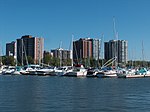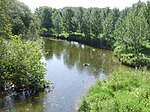Bronte Creek
Ontario river stubsRivers of Hamilton, Ontario

Bronte Creek is a waterway in the Lake Ontario watershed of Ontario Canada. It runs through Hamilton and Halton Region, with its source near Morriston (south of the intersection of Highway 6 and Highway 401), passing Bronte Creek Provincial Park, on its way to Lake Ontario at Bronte Harbour in Oakville, where the creek is also known as Twelve Mile Creek. Bronte takes its name from the title of the Duke of Bronté held by Horatio Nelson.Bronte Creek in Ojibwe is "Eshkwesing-ziibi", "Esqui-sink", "Eshkwessing", "ishkwessin", and "Asquasing" ("that which lies at the end").
Excerpt from the Wikipedia article Bronte Creek (License: CC BY-SA 3.0, Authors, Images).Bronte Creek
Lakeshore Road West, Oakville Bronte
Geographical coordinates (GPS) Address Nearby Places Show on map
Geographical coordinates (GPS)
| Latitude | Longitude |
|---|---|
| N 43.391944444444 ° | E -79.714166666667 ° |
Address
Lakeshore Road West
Lakeshore Road West
L6L 6L9 Oakville, Bronte
Ontario, Canada
Open on Google Maps








